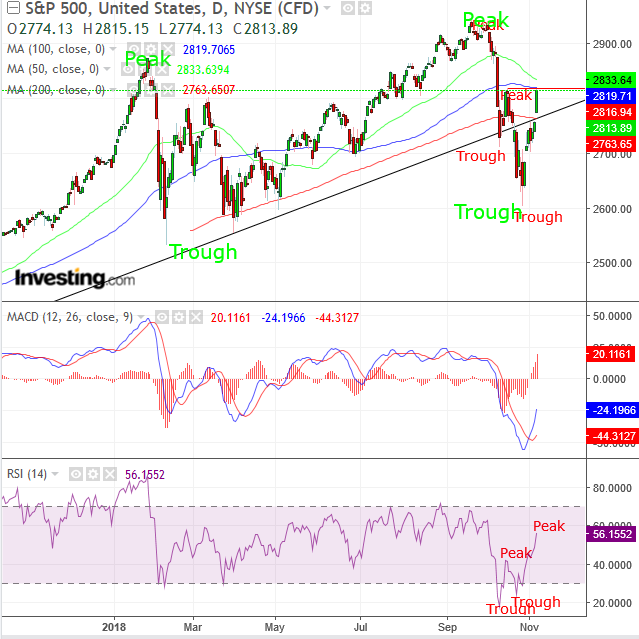
- All Instrument Types
- Indices
- Equities
- ETFs
- Funds
- Commodities
- Currencies
- Crypto
- Bonds
- Certificates
Please try another search

Chart Of The Day: S&P 500 At A Crossroads

Yesterday, after the results of Tuesday's US midterm elections were released, the S&P 500 vaulted higher. The benchmark saw its best close in nearly a month, up 2.12 percent.
Since the outcome of the voting likely met trader expectations, the sense of a return to stability seems to have fueled sentiment and a market environment agreeable to investors. When there's a divided government, in which Democrats control the House and Republicans hold sway in the Senate, fiscal policies are likely to remain in place, as both sides of the aisle lock horns.
Could this mean the benchmark index will keep going higher?

Technically, the benchmark is at a crossroads. In short, the midterm downtrend is in question. It may in fact rejoin the longer term uptrend. However, even the long-term trend, which continues to point higher, has now shown signs of weakening.
The SPX jumped back over both the uptrend line since its last double-digit correction in early 2016, passing the 200 DMA as well. Although it closed only 0.06 percent off the top of the session —demonstrating that bulls were in control—it stopped below the 100 DMA, backed up by the 50 DMA, which are closely followed by trend traders.
More important, it closed 0.11 percent from the previous peak of 2,816.94 posted October 17, forming a wall of resistance where a barrage of supply may be waiting to be triggered. Meanwhile, the 8 percent rally from the 2,600 level in late October followed the most oversold condition for the index since August 2015, during the double-digit correction preceding the January 2016 correction. Since then, the RSI has formed an ascending peak-trough pattern, and the MACD provided a buy signal.
Although the S&P 500's September 21 peak was higher than the January 26 peak, it was only greater by about 2 percent, thus not very convincing after rallies since the 2009 bottom went up at least to double digits high. Similarly, the October trough was less than 3 percent higher than the February through, showing a lack of buying interest.
The resulting pattern may be a massive H&S top.
Trading Strategies
Conservative traders must wait for a new peak to secure both long and midterm uptrends.
Moderate traders may risk a long position, should the price close above the October peak.
Trade Sample:
- Entry: 2850
- Stop-loss: 2830
- Risk: 20 points
- Target: 2910
- Reward: 60 points
- Risk-Reward Ratio: 1:3
Aggressive traders might take a bearish position, counting on the resistance of the October peak.
Trade Sample:
- Entry: 2820.00
- Stop-loss: 2820.0 above the October peak
- Risk: 20 points
- Target: 2600, the October low
- Reward: 220 points
- Risk-Reward Ratio: 1:11
Related Articles

As markets try to look through the blizzard of policy changes flowing out of Washington, the crowd has shifted its preferences considerably in recent weeks based on a sector lens....

Nvidia’s muted reaction keeps tech on edge, with chipmakers in focus. Nasdaq’s 20980-21000 support holds—for now. A break could mean trouble. With Nvidia done, GDP today and...

Nvidia’s earnings beat didn’t erase investor concerns over slowing growth. Soft Q1 guidance and valuation worries may limit the stock’s upside. Weak network and gaming sales...
Are you sure you want to block %USER_NAME%?
By doing so, you and %USER_NAME% will not be able to see any of each other's Investing.com's posts.
%USER_NAME% was successfully added to your Block List
Since you’ve just unblocked this person, you must wait 48 hours before renewing the block.
I feel that this comment is:
Thank You!
Your report has been sent to our moderators for review



Add a Comment
We encourage you to use comments to engage with users, share your perspective and ask questions of authors and each other. However, in order to maintain the high level of discourse we’ve all come to value and expect, please keep the following criteria in mind:
Perpetrators of spam or abuse will be deleted from the site and prohibited from future registration at Investing.com’s discretion.